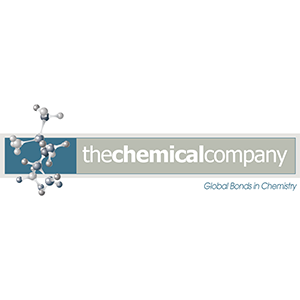TCC’s nitric acid (HNO3), is a highly corrosive and toxic strong mineral acid that is normally colorless but tends to acquire a yellow cast to the accumulation of oxides of nitrogen if long–stored. Ordinary nitric acid has a concentration of 68%. When the solution contains more than 86% HNO3, it is referred to as fuming nitric acid. Depending on the amount of nitrogen dioxide present, fuming nitric acid is further characterized as white fuming nitric acid or red fuming nitric acid, the concentrations above 95%. Nitric acid is also commonly used as a strong oxidizing agent.
Pure anhydrous nitric acid (100%) is a colorless mobile liquid with a density of 1.512 g/cm2 that solidifies at -42° C and forms white crystals. It boils at 83° C. Consequently, anhydrous nitric acid should be stored below 0°C to avoid decomposition.
Nitric acid is made by the reaction of nitrogen dioxide (NO2) with water. Normally, the nitric oxide produced by the reaction is re-oxidized by the oxygen in air to produce additional nitrogen dioxide. Adding sulfuric acid to a nitrate salt and heating the mixture with an oil bath can make almost pure nitric acid. A condenser is used to condense the nitric acid fumes that bubble out of the solution.
Industrially, strong nitric acid is produced by dissolving additional nitrogen dioxide in 68% nitric acid in an absorption tower. Dissolved nitrogen oxides are either stripped in the case of white fuming nitric acid, or remain in solution to form red fuming nitric acid. More recently, electrochemical means have been developed to produce anhydrous acid from concentrated nitric acid feedstock.
Commercial grade nitric acid solutions are usually between 52% and 68% nitric acid. Production of nitric acid is via the Ostwald process, named after German chemist Wilhelm Ostwald. In this process, anhydrous ammonia is oxidized to nitric oxide, in the presence of platinum or rhodium gauge catalyst at high temperature of about 500K and a pressure of 9 bar.
Applications
Nitric acid is used in the production of ammonium nitrate for fertilizers, making plastics, and in the manufacture of dyes. It is also used for making explosives such as nitroglycerin and TNT. When it is combined with hydrochloric acid, an element called aqua regia is formed. This is a reagent that is capable of dissolving gold and platinum. Additionally, it is used in a colorimetric test to distinguish heroin and morphine.
Nitric acid is commonly used in science laboratories at schools for experimenting when specifically testing for chloride. This is accomplished by adding a sample with silver nitrate solution and nitric acid to test if a white precipitate, silver chloride is present. In the field of medicine, nitric acid is used in its pure state as a caustic to remove chancres and warts. Diluted solutions are used in the treatment of dyspepsia.
Nitric acid has been used in various forms as the oxidizer in liquid–fueled rockets. These forms include red fuming nitric acid, white fuming nitric acid, mixtures with sulfuric acid, and forms with HF inhibitor.
It is also typically used in the digestion process of turbid water samples, solid sludge samples, as well as other types of unique samples that require elemental analysis via ICP-MS, ICP-OES, ICP-AES, GFAA and flame atomic absorption spectroscopy.
In organic synthesis, nitric acid may be used to introduce the nitro group. When used with sulfuric acid, it generates the nitronium ion, which electrophilically reacts with aromatic compounds such as benzene.
In electrochemistry, nitric acid is used as a chemical doping agent for organic semiconductors, and in purification processes for raw carbon nanotubes.
In a low concentration, nitric acid is often used in woodworking to artificially age pine and maple. The color produced is a gray–gold, very much like very old wax or oil-finished wood.
Nitric acid can be used as a spot test for alkaloids like LSD, producing a variety of colors, depending on the alkaloid.


